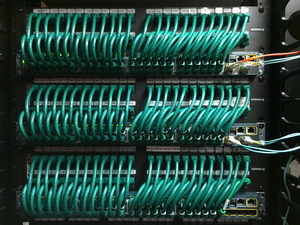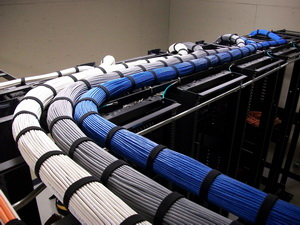Data & Voice Network Cabling Installers Minneapolis, MN
Data & Voice Cabling FAQs – Questions and Answers
Why Use Structured Cabling?
Structured cabling is the design and installation of a cabling systems that will support multiple hardware uses systems and be suitable for today’s needs and those of the future. With a correctly installed system your requirements of today and of tomorrow will be catered for and whatever hardware you choose to add will be supported.
Cat5e / Cat6 what’s the difference?
The general difference between Cat5e cabling and Cat6 cabling is in the transmission performance, and extension of the available bandwidth from 100 MHz for category 5e to 250 MHz for category 6. This includes better insertion loss, near end crosstalk (NEXT), return loss, and equal level far end crosstalk (ELFEXT). These improvements provide a higher signal to noise ratio, allowing higher reliability for current applications and higher data rates for future applications.
Should CAT6 replace CAT5e?
Industry predictions indicate that 80 to 90 present of all new installations will be cabled with category 6. The fact that category 6 link and channel requirements are backward compatible to category 5e makes it very easy for customers to choose category 6 and supersede category 5e in their networks. Applications that worked over category 5e will work over category 6. Cat6A and above are also taking over specifications for new installations, especially in data centres and Audio Visual Installations.
What is the maximum length of CAT5 – CAT5e cable?
90m for the permanent link installation and an allowance for 10m of patch cords at the ends combined.
What’s the maximum distance between cabinet and data points for Cat5e / Cat6?
The maximum is 90m between the patch panel and the data point.
What factors will affect the performance of Cat5e and CAT6cable?
Poor installation, poor terminations and inferior materials are the main issues with performance on cabling systems. If the cable is poorly installed and terminated then data loss and errors will be a continuous problem, from lost data, dropped VOIP Calls and poor Visual displays, Interference from other cables and outside factors such as electrical, microwave, lighting and noise will also affect the performance of the cable.
Cat7 – what is Cat7 cabling and why would I use it
Cat7 cable has increased performance and increased protection against outside interference. With a bandwidth of up to 600MHZ its increase in speed potential over Cat5e / Cat6 is considerable. Also each pair of wires (4 pairs) are individually shielded as well as an overall shielding for the cable itself. This provides a great protection from outside noise and interference. It’s especially useful in areas of high speed data transfer in large cable bundles and within the Audio Visual Industry.
What do I need to consider in terms of structured data cabling to future proof my business for the next 5/10 years?
The major decision is where your office will be based in the future and what requirements you have for your systems. Cat5e is suitable for Gigabit data and therefore suitable to most offices. However with Large files, Audio Visual distribution and CCTV innovations a Cat6 or Cat6a with future proof your offices for a longer period.
Can I use CAT 5 Cable in Power over Ethernet applications?
Cat5e and Cat6 can both effectively run POE applications up to 90m. However due to power dissipation there is better performance and power efficiently with Cat6a cabling running POE devices if being incorporated into a new design.
What is a patch cable?
A patch cable is used at the cabinet end for linking the dedicated cabling port to the required equipment in the communications cabinet. For example an outlet could be “patched” from the panel to a Data Switch, Telephone Switch, CCTV Switch, WIFI Switch Etc. The difference to standard cable is Patch cable is stranded for flexibility, whereas standard cable is solid copper.
Fiber optic cabling – when is it better to use Fiber?
Fiber cable carries greater Bandwidth and over longer distances. It is not limited by the 90/100m limit of copper cable and has distance potential of 40km in some cases. It also isn’t affected by noise or outside influences as are copper cables so is a perfect solution when linking cabinets through risers in a building. As a standard guide when linking separate cabinet’s Fiber Optic links should be used.
What is VoIP?
Voice over Internet Protocol (VOIP) use digital technology to send voice signals over your cabling infrastructure. Voice is converted to a data transmission and converted back to a voice signal at the users end.
VOIP – can I use VOIP over my existing network?
VOIP systems require a point to point cable from the VOIP systems to each user. If you telephone system is of the old daisy chain wiring (i.e. one telephone wired to the next telephone wired to the next telephone) then this will not support a VOIP systems. Also the existing cabling needs to be of good standard and terminated correctly and fully tested. A poor cabling install will result in a very poor VoIP quality call.
Disposal of old cabling – do you dispose the old cable?
Depending on the project and the feasibility of the current cabling we remove the old cabling as part of the new installation. This cabling is then taken back to be segregated and disposed / recycled as appropriate.
Cabling for schools. Do you provide data cabling for schools and colleges?
Yes and having been a preferred supplier for Minnesota's Schools for the past 15 years we have completed in excess of 300 projects within schools.
Do I only need 1 cable per person as I will plug my PC into my Phone?
Some phone systems allow you PC to access the internet down the same cable as your phone. However you are then limited to the speed of that phone (i.e. 100MB). Also you are limited in future options. If you choose to pick a different system that requires a dedicated line then you have to install all new cables. Our recommendation is when installing to each desk install a minimum of 2 per user (PC and Phone)
What disruption would data cable installation cause to my company – how long will we be out of action?
If the data cabling installation is new and doesn’t require unplugging your existing infrastructure then we can install without and disruption. TO facilitate this further we can install on weekends or in the evening when the building is empty to minimise disruption.
Can I get the builder to install the cable and you terminate and test?
This is not recommended due to the success of a cabling systems performance is its installation and its termination. Installation requires adherence to limited bend radius of the cables, separation from noise interference, and correct securing and bundling of the cable. This is part of the experience and expertise of the cabling installation contractor.
However in practical terms sometimes the cabling needs to be installed by the builder before the client takes the building. In this scenario we can trace, terminate and test the system but can’t guarantee the results will pass.
What do Data cable installation test results show?
Test Results show a range of tests depending on the grade of cabling used (Cat5e / Cat6 etc.). These tests for Cat6 include Wire Map, Length, Insertion Loss, NEXT Loss, PS NEXT Loss, ACRF Loss, PS ACRF Loss, Return Loss, Propagation Delay, Delay Skew. These are tests to ensure installation standards have been met, the terminations have been done correctly and that the cable doesn’t have any unnecessary bends, kinks and twists.
Do I need a cabinet, can’t I just plug straight into my equipment?
A cabinet is always recommended even for the smallest installs. Cabling plugged directly into equipment has a tendency to break away at the termination ends as solid cable is not suitable for direct termination. Also a cabinet provides protection for the equipment from theft, breakage, dust and employees. Cabinets also allow all the equipment to be stored together and in a manageable way for moves and changes.
Why do I need such a big cabinet?
The cabinet should be large enough to house the current equipment with some space for possible future requirements. I.e. for a VOIP telephone system to be housed. The depth of the cabinet should keep in mind what is to be stored in the cabinet. Some ISP switches and blade servers are extra deep and required a 800/1000mm deep cabinet.
Why do you use LSOH (Low Smoke zero Halogen) cable on our installations?
Most network cables are insulated with polyethylene, PVC or thermoplastic polyurethane. In a fire, a chlorine containing plastic material releases hydrogen chloride, a poisonous gas that forms hydrochloric acid when it comes in contact with water. Low smoke zero halogen cable reduces the amount of toxic and corrosive gas emitted during combustion.
Do you charge for an initial survey?
Initial surveys are free as are introductory meetings for design. However visits to explore faults etc. that require an engineer are charged at call out rates.
What times are your normal working hours for engineers?
Our normal working day is Monday – Friday between 8-5, but we can also work before/after these hours if required. In many cases out of hours working is charged at the same rates depending on requirements, location and hours.
Do you charge extra for weekend and evening work?
In many cases we offer weekend working at the same rates as normal hours. This depends on location, requirements and hours. Evenings depend on how many evenings will run in succession.
More questions on Data Cabling?
Just give us a call. Or take advantage of our free Data Cabling survey –we offer expert advice to clients planning to set up, upgrade or expand data cable installations – just drop us a line or call.



